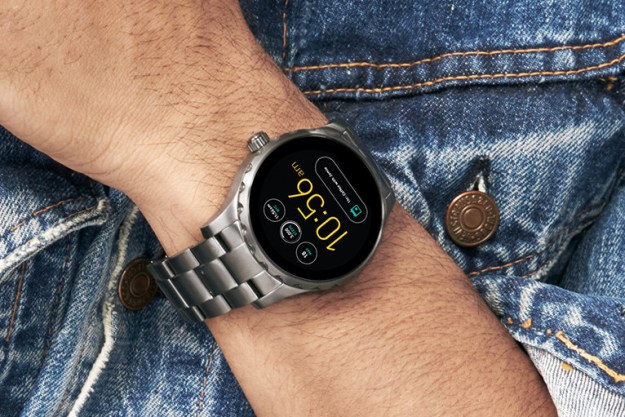The Orion Onyx takes some getting used to, but could be extremely useful for teams who need to remain in constant contact.
Digital communication is easy. But it could be easier. Imagine touching a wearable button to send a voice message to someone else. You could tell your personal assistant to book an event in your calendar, or send a message to your significant other, reminding them to pick up milk at the store — all without taking out your phone or even looking at a screen.
That’s the idea behind Onyx, a wearable communications device that clips to your shirt or bag. Simply push the button, say what you need to say, and that message will be transmitted to the person or people you select. This is perfect for those working in a team with members spread across multiple locations, or anyone who wants (needs?) to remain in constant contact with someone else.
So just how easy can communication get?
Setup
Onyx is a wearable, so fashion has to be taken into consideration when evaluating it. And ultimately from where I sit, the device passes the test: It’s certainly not bad-looking at all. It’s sleek and fun, and the clip makes it easy to put wherever you want it, provided it’s near enough to your mouth to pick up your voice.
As mentioned, Onyx isn’t ugly, but it is noticeable. It’s 2 inches across, so it’s not going to pass for a shirt-button. The outer shell is largely made of plastic, while the clip and the backing is made of metal. The plastic doesn’t necessarily give it a cheap feel, but iPhone-like premiumness isn’t what Orion is going for either. The plastic on the front is smooth and polished, and comes in four colors; black, silver, blue, and pink.
The only gripe I have with Onyx is that it’s intrusive. It’s a button you wear on your clothing, but it’s nowhere near as small as those on your shirt or pants, unless you happen to wear clothes with huge, Mickey Mouse-style buttons. If Onyx becomes part of your work attire or is something you wear when you need it, then that’s one thing, but you’re probably not going to put on Onyx and then forget about it.
Setting up the device is a snap. Simply download the app, make sure Bluetooth is switched on, and follow the instructions to connect the device to your phone.
After the device is connected, the app will ask to scan your contacts for others who own Onyx devices. Once it finds them, they can be added to your list of contacts, and you can either join an existing group or create a new one. You can also test out the device using the “Echo Chamber,” which basically just plays back what you say. It’s a nice way to get acquainted with the device.
Day-to-day use
Setting up the device wasn’t hard at all, but coming back to it the next day was. I plain forgot how to use the unfamiliar device — it would be nice to see a little “how-to” section in the app with instructions on how to turn on Onyx and what the different modes are. Sure, it’s on me for forgetting how to use Onyx, but this device doesn’t make things easy. To switch it off, you hold down the button and turn the face to the right. To turn it back on, you turn the face back to the left, then hold the button down again and turn it to the right, the same direction you would rotate the face to switch it off. Read that again – I’ll wait. This is hands-down the least intuitive way to activate a product that I’ve ever seen. What’s wrong with turning it one way for on and the other way for off? Or a simple on/off switch?
“Apart from taking a little getting used to and being a little oversized, it’s very good at what it does.”
Onyx has three statuses when it’s on. When active, it’s ready to hear what you have to say, and all you have to do is press and hold the button. Once you do that, it enters a second stage, called “talk.” As you might imagine, this is when it’s listening to you and ready to transmit audio after you release the button. The third stage is “silent,” and to enter it you turn the face to the right (don’t hold down the button of course). Silent means it’s not listening, no audio is being sent or received, and Onyx is basically in standby mode.
Once you get used to how the device works, it works quite well. There’s an audio control on the side; it gets pretty loud in case you’re using it in a bustling office, and pretty quiet in case your work atmosphere is more subdued and you have a co-worker in the cubicle two feet to your left. Although, in that case, you might be better off using the included headphone jack. Audio is easy to record and is sent immediately provided you have a decent Internet connection on your phone – sure, it’s not the highest quality audio, but that’s beside the point. What matters is that voices are hearable, and they very much are.
This may go without saying, but in order to use Onyx you need an Internet connection. The device doesn’t send audio itself, but rather uses your phone’s connection. It doesn’t matter if your phone is linked using Wi-Fi or a data connection: Onyx just needs to be connected. It’s also important to keep an eye on the device’s battery, especially if you rely on it a lot. It will warn you when you’re running out of juice, and it will definitely last through the day even with heavy use, but it’s still something to remember.
A few times I had trouble connecting Onyx – if I switched it off and then back on again, it would “connect” to the app but wouldn’t send audio. The app would say it was playing back audio, but nothing would sound. Manufacturer Orion Labs told me that this is still very much early days for Onyx and bugs are being ironed out, so it’s likely that this will disappear. In any case, a quick fix is to close the app and open it back up again.
On a budget? Make phone calls
Onyx isn’t overly expensive, but it’s not cheap either. It comes in a two pack for $250, or if you only need one you’ll pay $130. Larger companies can consider a 12 pack for $1,300.
This is probably something you should considering asking your company to buy you if you think it could really help your workflow. Alternatively, you and your bestie can go halvsies on a two-pack so you can chat all day, every day.
Warranty
At this sort of price, you would expect the device to last a while, and while it should last a few years, Orion only offers a 1-year warranty after the purchase date. Keep in mind that after that year you’ll be on the hook for a new Onyx if yours breaks.
Speaking of breaking, you’re going to want to be somewhat careful with Onyx – don’t go swimming with it, for example. The device has an IP5x dust rating, which basically means that it shouldn’t break thanks to dust unless there’s an abnormal amount. Unfortunately that also means that it’s not rated for water – you may have trouble even in the rain with the Onyx. Try and keep it out of the water as much as you possibly can.
Conclusions
Let’s be clear. Onyx is not a device to buy just for the sake of it. Smartwatches may feel a bit gimmicky, but at least they’re really just fun to play around with. Onyx isn’t that fun to play with, but then again it doesn’t need to be. Onyx is for you if you’re a part of a team that needs to remain in contact. Whether that is a larger team of 10 people working on something together or a couple who needs to stay in touch at all times for some reason, Onyx is a team device.
Apart from taking a little getting used to and being a little oversized, it’s very good at what it does. It sends audio quickly, is loud enough to be heard in most environments, and is well designed. If you’re part of a team that needs to remain in contact as easily as possible, consider Onyx. If not … well, phones and tin cans on strings still work, right?
Highs
- Well-built with fun color options
- Great volume range
- Easy to use once you get used to it
Lows
- A little big
- Somewhat pricey
- Hard to get used to





